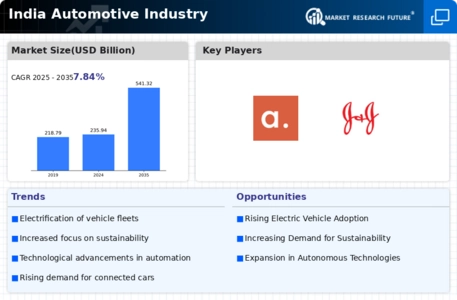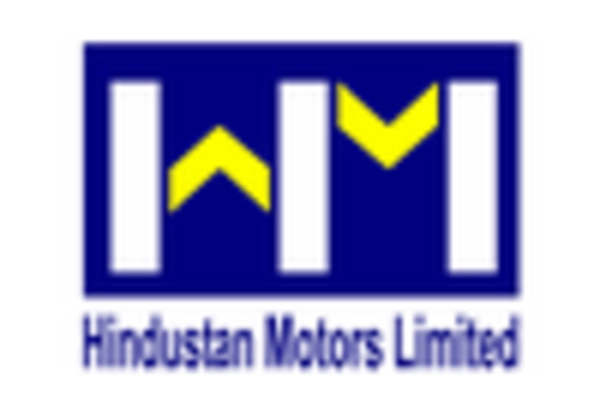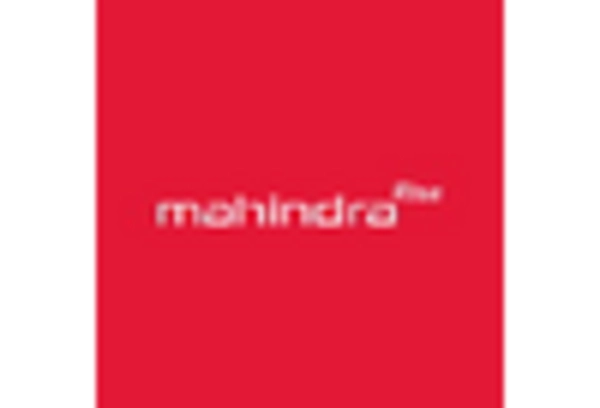Growing Middle-Class Population
The expanding middle-class population in India is a pivotal driver for the India Automotive Industry Market. As disposable incomes rise, more consumers are inclined to purchase personal vehicles, leading to increased demand. Reports indicate that the middle-class segment is projected to reach 600 million by 2030, which could significantly boost vehicle sales. This demographic shift not only enhances the purchasing power but also influences consumer preferences towards more advanced and feature-rich vehicles. Consequently, automakers are likely to tailor their offerings to meet the evolving needs of this burgeoning market segment, thereby stimulating growth within the India Automotive Industry Market. This shift also reflects broader trends in the auto industry in India, where manufacturers are increasingly focusing on innovation, sustainability, and consumer-centric designs. As demand patterns continue to change, the automobile market in India is expected to expand steadily, especially within the car industry in India, which is experiencing rapid transformation driven by technological advancements and shifting consumer preferences.
Government Initiatives and Policies
Government initiatives aimed at promoting the automotive sector play a crucial role in shaping the India Automotive Industry Market. Policies such as the Faster Adoption and Manufacturing of Electric Vehicles (FAME) scheme and the Production-Linked Incentive (PLI) scheme are designed to incentivize manufacturers and consumers alike. These initiatives are expected to enhance domestic production capabilities and encourage the adoption of electric vehicles. For instance, the PLI scheme aims to attract investments worth approximately USD 8 billion in the automotive sector, which could lead to significant advancements in technology and infrastructure. Such supportive measures are likely to create a conducive environment for growth in the India Automotive Industry Market.
Technological Advancements in Manufacturing
Technological advancements in manufacturing processes are transforming the landscape of the India Automotive Industry Market. The adoption of automation, artificial intelligence, and robotics is enhancing production efficiency and reducing costs. For example, the implementation of Industry 4.0 technologies is enabling manufacturers to optimize supply chains and improve quality control. This shift towards more sophisticated manufacturing techniques is not only increasing output but also allowing for greater customization of vehicles. As a result, automakers are better positioned to respond to consumer demands and market trends, thereby fostering innovation and competitiveness within the India Automotive Industry Market.
Urbanization and Infrastructure Development
Rapid urbanization in India is significantly influencing the dynamics of the India Automotive Industry Market. As more people migrate to urban areas, the demand for personal and public transportation is escalating. The government is investing heavily in infrastructure development, including road networks and public transport systems, which is expected to facilitate smoother mobility. Reports indicate that urban vehicle sales are projected to increase, driven by the need for efficient transportation solutions. This trend is likely to encourage automakers to innovate and adapt their products to meet the specific needs of urban consumers, thereby propelling growth in the India Automotive Industry Market.
Rising Demand for Sustainable Mobility Solutions
The increasing awareness of environmental issues is driving the demand for sustainable mobility solutions within the India Automotive Industry. Consumers are becoming more conscious of their carbon footprint, leading to a surge in interest for electric and hybrid vehicles. Market data suggests that the electric vehicle segment is expected to grow at a compound annual growth rate (CAGR) of over 40% in the coming years. This shift towards sustainability is prompting manufacturers to invest in cleaner technologies and develop eco-friendly vehicles. Consequently, the focus on sustainable mobility is likely to reshape the product offerings and strategies of companies operating in the India Automotive Industry Market.


















Leave a Comment